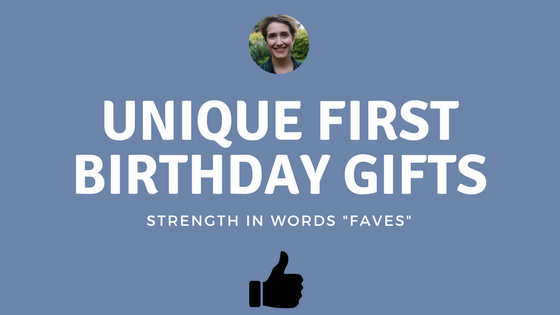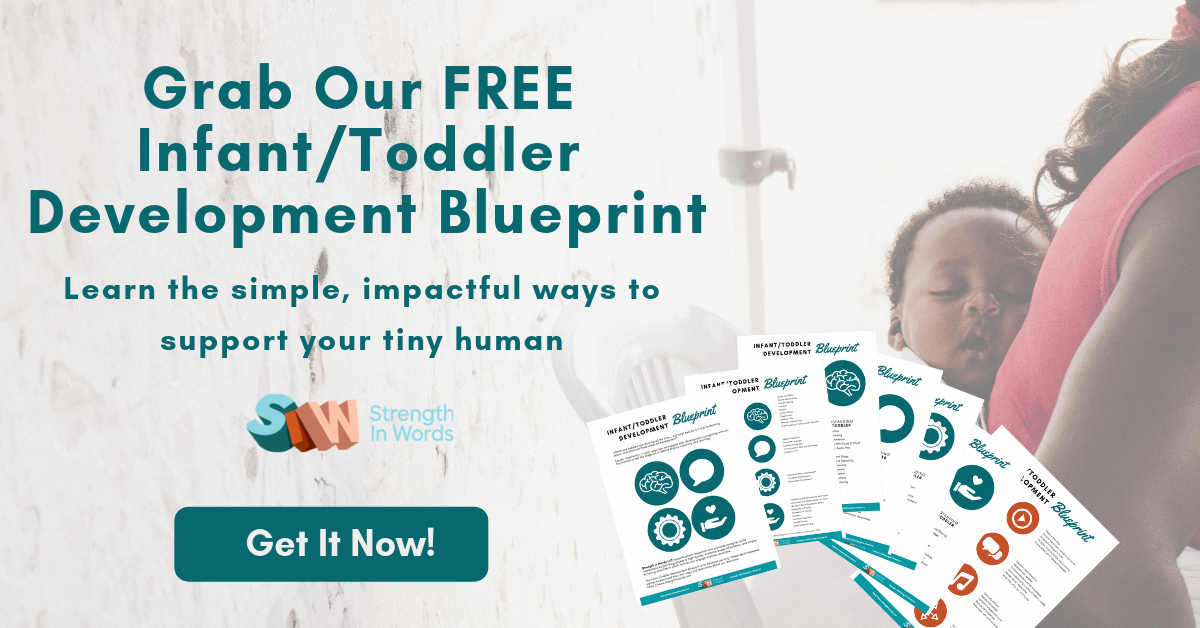The transition from infant to toddler
As a parent, you’ve seen your child make incredible gains in just 12 months – from a tiny, completely dependent person to one who is becoming more mobile, thoughtful, expressive, and independent each and every day.
Around the age of one year, a child is often starting to put together a lot of information.
Major developmental milestones are often acquired, such as first words, first steps, etc… but these milestones are symptomatic of something much larger.
From day one, your baby has been an excellent scientist, a statistician, and has been making sense of patterns and information in her environment.
Around 12 months we start to see more advanced forms of play emerge, and, even though we know that even young infants are categorizing information, understanding adult intentions, and are able to engage in many forms of non-verbal communication, our one-year olds start to use objects in play in a way that allows us to see all this much more clearly!
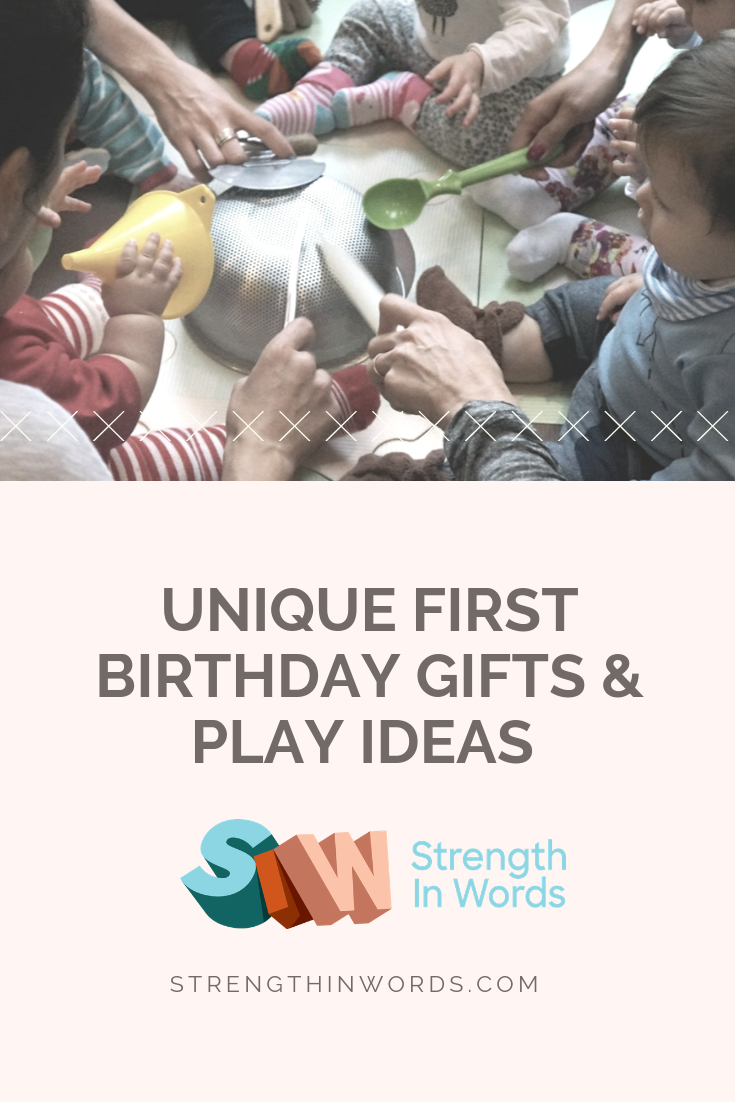
We all want to ensure that we mark our child’s first journey around the sun in a special way. We want to find unique first birthday gifts for the little people in our lives: we want to make a memorable first birthday!
Now, it may be tempting to succumb to the idea that because a one-year old’s brain is becoming so much more sophisticated, she must need more sophisticated toys and play materials?… toys that sing and move, that talk and claim to teach colors, animal names and counting…
From a developmental perspective… that assumption would be wrong.
No matter what kinds of toys you have, it often seems that infants and toddlers around the age of 12 months gravitate to objects commonly found in your home.
Have you ever caught your little one banging on the pots and pans as if they were drums? Playing with wooden spoons, pretending to stir?
Putting a mixing bowl on his head and pretending it’s a hat or playing peek-a-boo?
The play materials you purchase (or let your child play with) that fall into the category of “open-ended toys” are not only going to give you the most bang for your buck…
They have the added advantage of being excellent to encourage all kinds of appropriate and important development, often supporting cognition, communication, motor/sensory, and social/emotional development.
The most unique first birthday gifts…
When I’m shopping for a child’s first birthday gift, I want to know that the gift the child receives is going to be used. I want to make sure that first birthday gift is going to be memorable.
I want that gift to be original, and I definitely want to know that I’m buying a birthday gift that supports that child’s development.
Optimally, it could even be reused or repurposed once the child was finished playing with it!
Gift Ideas for A First Birthday
Important note: These are open-ended, real materials with which your child is meant to experiment – that’s what play looks like! T
hey are also meant to be used to support your relationship and interaction with your child, under direct adult supervision!
Try to remain flexible, follow your child’s lead, and remember that objects can be used in lots of different ways!
Watch as everyday kitchen items transform into stacking blocks, peek-a-boo games, musical instruments, sorting areas, etc.!
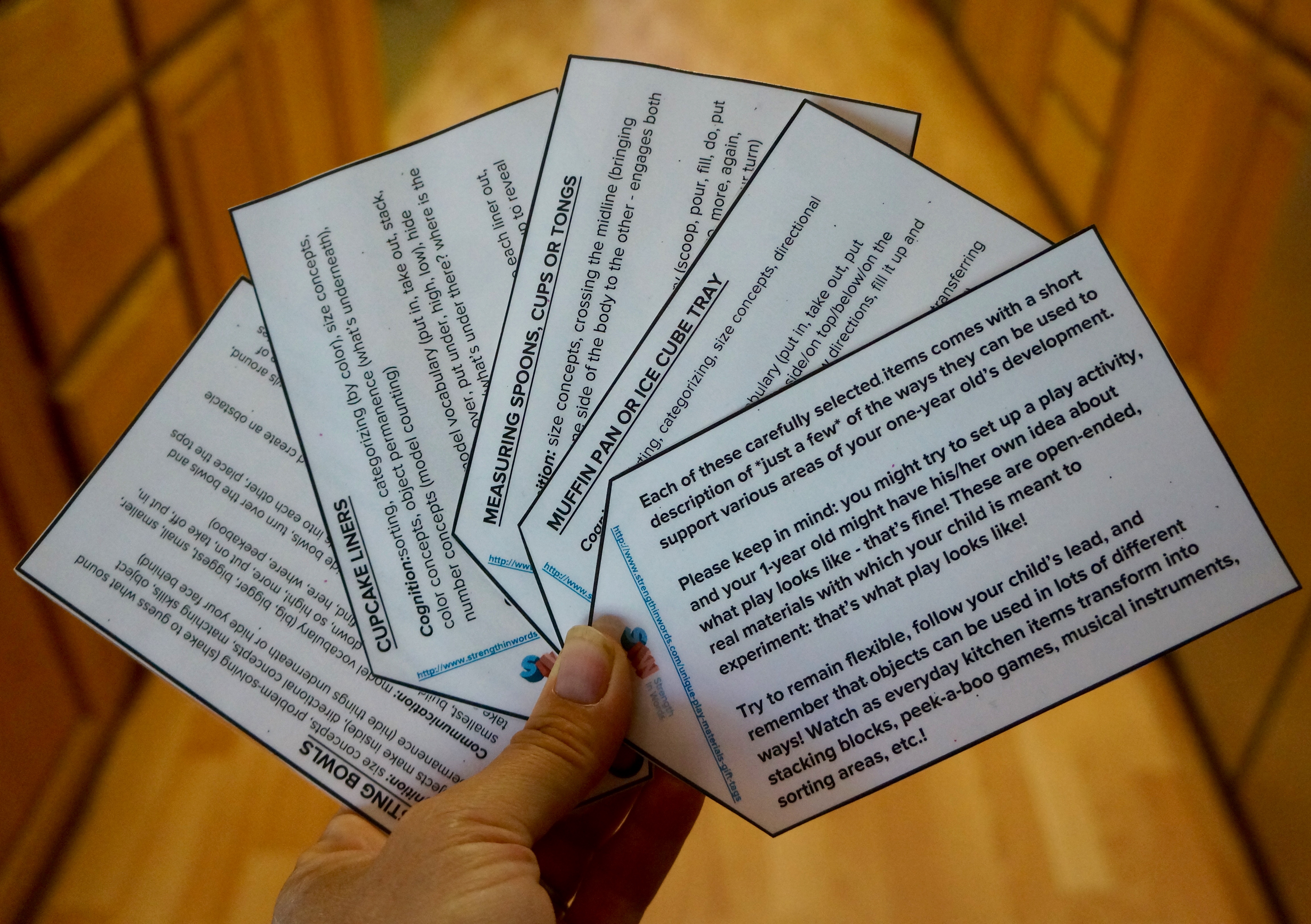
Below, I’ve outlined a few great ways to use each item to promote communication development… but there are wonderful, simple ways to use each of these items to also support cognitive, fine motor, gross motor, and sensory development as well!
If you are looking for a unique gift idea for a one year old’s birthday, consider the Learn With Less download, Unique Play Materials: Gift Tags for a First Birthday. >> Learn more by clicking here, or add straight to your cart here! This post contains affiliate links, meaning that I may receive a small portion of the total amount if you make a purchase using this link – at no cost to you!
Looking for a unique first birthday gift?
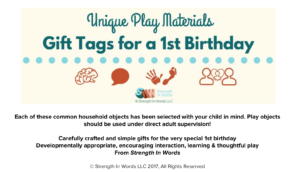
Kitchen Timer
A mechanical timer like this one is the one item on this list that resembles a “cause and effect” toy. However, I wanted to demonstrate that sometimes, these are valuable toys as well.
Communication Development:
* Model vocabulary (e.g., turn, go, long/short, etc).
* Model excitement for the timer to go off by using gestures or facial expressions.
* This particular timer could also target animal vocabulary (e.g., chicken, cluck, etc).
Nesting Bowls
Nesting bowls are great gifts for a one-year old because they are the DIY version of a nesting toy (e.g., nesting dolls or blocks).
Communication Development:
* Target vocabulary for size concepts and superlatives (e.g., big/bigger/biggest) or directional concepts (up/down, high/low, on/off), color vocabulary, or actions (e.g., hide, show, find, put, take).
* Support development of object permanence by hiding things inside each bowl or cup.
* You can see an adorable set of nesting cups here, as well, which beautifully illustrate ways to incorporate more vocabulary (e.g., baby, shell, mama/daddy, open, close, in, out).
Measuring Spoons, Measuring Cups & Tongs
Measuring cups, spoons and tongs are also great one-year old gifts because, like nesting bowls, the former two can easily target size concepts. Tongs can help target problem-solving.
Communication Development:
* Model vocabulary for actions (e.g., scoop, pour, fill, do, grab), prepositions (e.g., put in, take out, pick up), social or requesting words (more, again, another), or colors.
*Practice turn-taking and model pronouns (your turn, my turn).
* The collapsible measuring cups can provide additional vocabulary targets (in, out, flat, deep)
Basting / Pastry Brush
Pastry brushes can be used to compare and contrast the similarities and differences of each side (brush vs stock) – how it looks, sounds, or how it can be used.
Communication Development:
* Bang them against something on each side to practice listening skills (auditory discrimination)
* Use them in symbolic play (e.g., to brush hair or teeth).
* Target vocabulary (dip, paint, up, down, on, off, more, a lot, a little, hard, soft)
* Use the brush as a tool to paint various surfaces such as body parts (paint nose/arm/leg) – using water or edible paints!
*Describe the way the brush sounds when used on various surfaces (e.g., a mixing bowl, the floor, a drum).
Sifter, strainer or colander
Sifters, strainers and colanders are great play or gift ideas because they provide excellent opportunities for problem-solving (how does it work) and so many other skills.
Communication Development:
* Model vocabulary (e.g., on, off, too big, small, sift, strain, put in, take out, go through, go in).
* Model inferencing (what’s going to happen next? I think ____)
* Engage in symbolic play – wear the colander as a hat!
* The collapsible nature of the colanders featured here adds additional vocabulary possibilities (flat, round, big, small) – not to mention, this makes storage much easier!!
Ladle and wooden spoons
Ladles and wooden spoons are great for making comparisons and matching games.
* Target vocabulary (e.g., bang, stir, lift up, put in, move around, pour out).
* Create movement games and engage the body – the spoons could be lined up for a child to hop, step, or crawl over or around, or you could make a spoon circle, going in and out! I can think of a million ways to incorporate movement and music into wooden spoon play!
* Imitate movements and rhythms, or call attention to the syllables in a word. The wooden spoon makes a wonderful drum mallet!
* I love the spoons pictured here – the handle colors could be used to match colors with different objects!
Muffin Pan & Ice Tray
The possibilities for sorting and categorizing are endless, as are the ways you might play with size concepts and directional concepts.
* Target vocabulary: in additional to any objects (nouns) you or your child decide to sort and place in and out of the containers, try phrases about what the child is doing or what you are doing, prepositions, adjectives and social words (e.g., put in, take out, put under/next to/above/on the other side/on top/below/on the bottom/colors/more/full/empty),
* Give or follow directions (perhaps with an older child as a partner) or simply imitate what the toddler is doing
* Place a preferred object into each hole – fill it up and then pour it all out!
Cupcake liners
Cupcake liners, especially those made from silicone like the ones pictured here, can be used much like other stacking toys (like blocks or nesting toys).
* Model vocabulary for size, color and shape
* Build a child’s understanding of object permanence (what’s underneath it?)
* Build understanding of number concepts (model counting how many are stacked up).
*Model vocabulary (e.g., put in, take out, stack, more, less, turn over, put under, high, low, colors).
* Hide objects and ask questions (what’s under there? Where is the ___?) to model the asking of questions and wondering aloud.
How would you use these objects to encourage communication development? Answer in the comments below!
